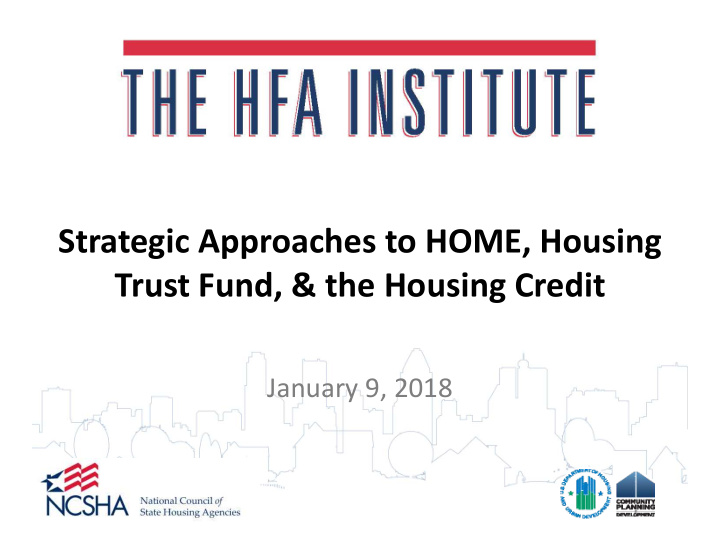



Strategic Approaches to HOME, Housing Trust Fund, & the Housing Credit January 9, 2018
Welcome & Introductions • Sponsored by: – HUD’s Office of Affordable Housing Programs – NCSHA • Trainer: – Steve Lathom, TDA Consulting slathom@tdainc.org 517‐203‐4130 Slide 2
Topic Overview • High level comparisons, critical distinctions – State role, income/rent targeting, compliance period • Implications for deal/transactional terms • Regulatory differences btw HTF & HOME – May affect “best fit” resource for specific projects Slide 3
Critical Distinction – State Role • We all want – Good deals, max, production, strong mission • BUT… • LIHTC Allocator – Failed deal = opportunity cost • HOME PJ/HTF Grantee – Failed deal = State must repay HUD Slide 4
Critical Distinctions ‐ Income • Income – HTF: 30% AMI (not less than poverty) • Some at 50% if over HTF $1B – HOME: 50%, 60%, and 80% • Often PJs limit to 60% AMI – LIHTC: 50% or 60% AMI • Deeper targeting often encouraged by QAP scoring • Limits change differently – Timing and hold harmless Slide 5
Critical Distinctions ‐ Period • HTF: 30 years • HOME: 15* (rehab) or 20 years (new) • LIHTC: 15 federal (+ 15 state‐enforced) – Planned investor exit Slide 6
Distinctions Drive Transactional Approach • HOME/HTF v. Credits: More accountability for longer with less revenue • In turn, drives deal points – 1 st mortgage considerations – Control over reserves – Expectations for owners – Agreement provisions* • Consult your own counsel! Slide 7
1 st Mortgage Considerations • Recording position v. covenant/use restriction – Non‐foreclosable covenant – FHA allows covenant senior to security instrument – Lenders regularly allowing • Key: Explicitly establish expectations up front • 1 st Mortgage term – Risk with balloon w/in affordability period • Will credit conditions allow refi? – Consider requiring term => affordability period Slide 8
Reserve Considerations • State control of reserves – Hold & disburse ↔ dual signature account ↔ report & default • Maintain reserves w/in project at investor exit – Don’t allow use for exit taxes, etc. • If drawn, require reserves be replenished prior to distribution of cash flow • Provide for periodic CNAs, reset RR deposits Slide 9
Idea – Preservation Reserve • Cannot provide additional HOME/HTF funds during affordability period • In lieu of cash‐flow contingent HOME/HTF payment, consider deposit to “Preservation Reserve” – e.g. 50% of annual cash flow to preservation reserve – Available if deemed necessary by state to preserve ongoing economic/physical viability within the affordability period, requires workout MOU – Upon maturity, available to repay HOME/HTF loan Slide 10
Ownership Expectations • Control changes in underlying ownership – Expect investor exit w/in affordability period – Remember 20 yrs HOME new/30 yrs HTF • Seek guarantees of performance from underlying owners – Can require personal guarantees within non‐ recourse loan constraints – “Repayment” guarantee and RR deposits Slide 11
Agreement Provisions – Pending Guidance • Pending policy requirements – e.g. Treatment of over‐income in‐place tenants As of the date of this Agreement, HUD has not issued guidance specifying the actions an owner must take to correct such temporary noncompliance. Owner agrees that, upon notice by the State following issuance of such guidance by HUD, it will be bound by those requirements as if they were included in this Agreement as of its execution. Slide 12
Agreement Provisions – Future Changes • Rules may change, or we may get it wrong Notwithstanding any terms within this Agreement, in the event that (i) HUD imposes new or modified requirements on existing HTF‐assisted projects through regulation, administrative notice, publication, or other notice, or (ii) HUD specifically identifies violations of HTF program requirements pertaining to this Agreement or the Project, Owner agrees to comply with any new or modified requirements to ensure the Project remains in or is brought into compliance with such requirements. Slide 13
Agreement Provisions – Standard Oversight • State’s oversight approach may change, standardize across portfolio when possible and appropriate Project shall, at all times during the term of this Agreement, be operated in compliance with the State’s Rental Management Handbook, or successor publications, which may be updated from time to time to reflect new, revised, or clarified administrative procedures and practices. Owner agrees to be bound by such updates… Slide 14
Regulatory Distinctions • LIHTC does not trigger cross‐cutting regs • HOME/HTF do trigger cross‐cutting regs HOME HTF * Environmental Review Uniform Relocation Act Sec. 104(d) 1:1 Replacement Accessibility (Sec. 504, etc.) Lead Based Paint (24 CFR Part 35) Sec. 3 Davis Bacon & Related Acts 24 CFR Part 5, Subpart A Affirmative Marketing Slide 15
HOME v. HTF • Exactly the same, except when they’re different – May affect project selection • HTF v. HOME – No Davis Bacon – Environmental review path – Requires annual project audit – Utility allowance options Slide 16
Predictions for 2018 and beyond • Are you kidding me? • [Placeholder for news since printing slides] • LIHTC market uncertainty following tax bill – Pricing and deal terms/structuring • HUD guidance – Operating Assistance/Reserves – Allocation levels/Action Plan timing Slide 17
Slide 18
Recommend
More recommend